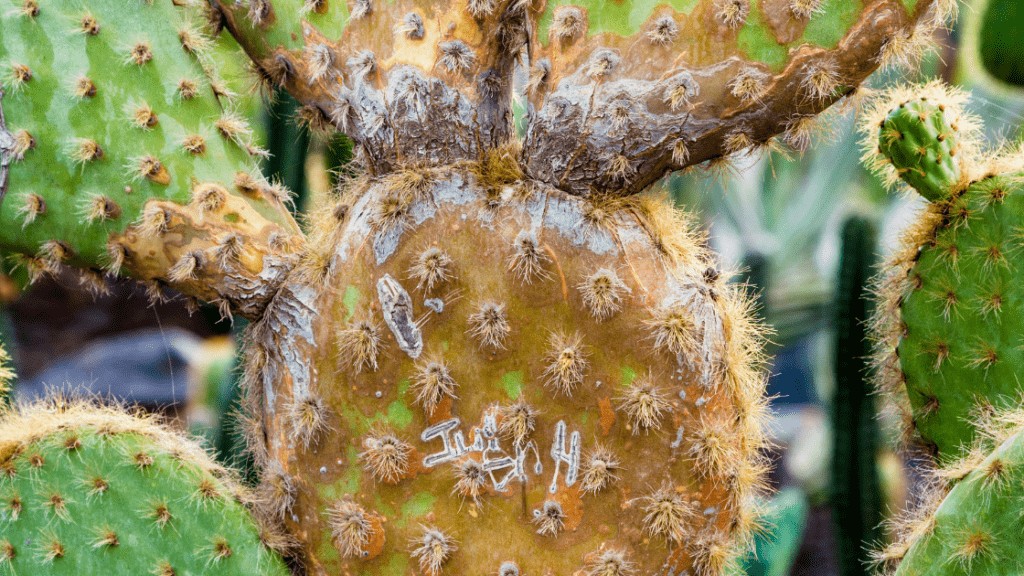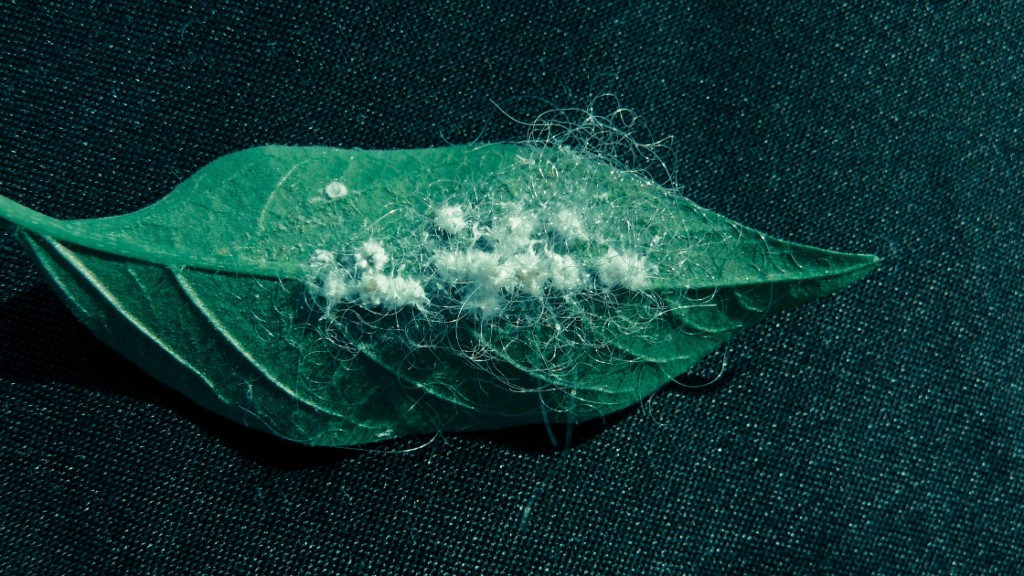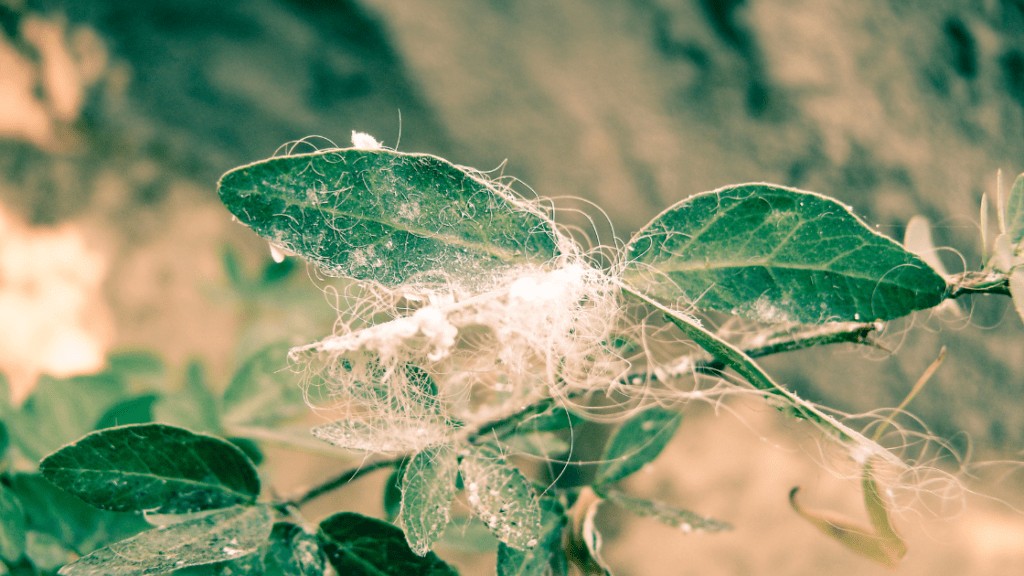
White fuzz is a very commonly observed phenomenon in many cactus species. Sometimes the fuzz is completely harmless and is a natural part of the cactus – Echinocactuses in particular tend to develop fuzz at the base of their spines, which people often get needlessly concerned about, and most often, its a mealybug infestation.
The development of natural, harmless fuzz in cactuses is well illustrated by a cactus species known as ‘the old man cactus’ (Cephalocereus senilis) – the whole body of this succulent is naturally covered in a fuzz that looks like cotton candy. As it turns out, the white fuzz produced by this cactus consists of modified spines that are very thin and long. This is a protection mechanism which the cactus has developed to guard itself from the scorching desert sun. In this article, we’ll explore the possible causes of white fuzz, how to identify them and how to deal with them – as you’re about to learn, fuzz is not always natural and harmless and can be caused by an infestation with tiny, juice-sucking insects.
What Causes White Fuzz on Cactuses and How To Identify It?
It’s important to recognize the difference between the harmless white fuzz which many cactus species naturally produce, and the problematic fuzz caused by insect parasites.
Browse our Affiliate Products
It’s very easy to tell the two apart by just looking at symmetry – if the fuzz appears on the whole body of the cactus and has no ‘hot spots’, this usually means it’s harmless and naturally produced by the succulent. As shown below.

The fuzz produced by mealybugs is easy enough to spot – these bugs are relatively large (about 1/20th of an inch), making them visible to the naked eye if you look closely. Mealybugs like to concentrate in one spot and don’t evenly colonize the whole surface of the cactus.

However, if there’s a concentration of fuzz near the top of the body of the cactus, this can still be a common, harmless feature of many Echinocactuses and other cactus species.
The best way to tell mealybug fuzz from harmless, natural fuzz is to use a cotton swab – because the fuzz that grows out of the spine base of cactuses has fibers that are actually attached to the plant, it won’t come off easily.
Mealybug fuzz on the other hand is not strongly attached to the surface of the cactus and is easily removed by swabbing. By carefully inspecting the fuzz collected on the swab, tiny bugs or eggs may be observed.
What Common Problems Can Lead to White Fuzz?
If you’ve determined that the white fuzz on your cactus is indeed caused by mealybugs or other parasitic insects, it’s important to eliminate the underlying issue that has created an environment suitable for those pests.
Let’s take a quick look at the factors that can contribute to a mealybug infestation.
Humidity
The biggest factor is humidity – mealybugs don’t normally infest cactuses and are much more common in plants that love high humidity. The high humidity creates a suitable environment for those bugs, which then start damaging the hard outer layer of the plant.
Once that layer is penetrated, the bugs have free access to the juices of the succulent, enabling them to reproduce and thrive.
High temperatures
Mealybugs love warm temperatures. Since cactuses are desert plants that thrive in hot weather, it only makes sense that they would be very vulnerable to a mealybug infestation. However, this is not the case in their natural habitat – the nighttime temperatures in the desert are very low, sometimes falling below freezing.
This natural 24-hour cycle makes the natural habitat of cactuses very mealybug-resistant. This is obviously not the case for indoor cactuses which experience constant high temperatures without much of a dip during the night.
Tissue damage
Over-fertilization and over-watering can both lead to tiny lesions forming on the surface of the cactus, making it easy for mealybugs to penetrate the surface and start feeding. Keeping your succulents healthy in general and avoiding stressing them can greatly reduce the chance of a mealybug infestation.
Sometimes, mealybugs can infest your succulents even in the absence of those risk factors. This can happen if there’s a sufficiently large number of them attacking the plant – a large number of mealybugs can often be brought home with fresh produce purchased at the supermarket.
A sufficiently large ‘army’ of them can then start invading your indoor plants even if the conditions aren’t very favorable for the bug.
Optimal Growing Conditions For Preventing White Fuzz In Cactuses
As we mentioned, keeping your succulents in good health can make them more resistant to pests like mealybugs. Improper lighting, poorly draining soil or constant high temperatures can all reduce the defenses of the plant and make its outer layer more easily penetrable by the claws of mealybugs, known as denticles.
For more information on other types of cacti and succulents click here: Cacti and Cactus Category
Sunlight
Providing a sufficient amount of direct sunlight for your succulents will harden their outer layer and cause anthocyanins and other protective compounds to accumulate. This makes the succulent much more resistant to infestations.
Temperature
Moderate, constant temperatures are very conducive to a mealybug infestation – by placing your succulents outdoors during the summer, the natural high temperature during the day and low temperature during the night can greatly reduce the chance of mealybugs reproducing and thriving.
Soil
Mealybugs can be spread by planting succulents in infested soil. If that’s the case, the issue can be very difficult to control. It’s important to note that a separate species of mealybugs, called ‘root mealybugs’ or ‘soil mealybugs’ actually live in the soil and infest the roots of plants, including succulents.
This can lead to white fuzz developing on the actual roots and not on the body of the cactus. This problem is difficult to solve, but less frequent watering can help.
For more information on soils, click here. What Are The BEST Potting Soils for Every Type of Plant?
Watering
Watering your succulents in a way that enables water to wet the body and accumulate on the surface is a sure-fire way to create a suitable environment for pests. At first, this leads to the formation of invisible molds, which start damaging the surface of the cactus, eventually creating a perfect environment for insects to effortlessly start drinking the juices of the succulent and to lay eggs. Avoid wetting the body of the cactus and don’t water too frequently.
How to Treat White Fuzz Caused By Parasitic Insects – What Can Be Done?
Mealybugs, which are the most common cause of problematic white fuzz can be easily dealt with – any type of insecticide works great on them and even soapy water can do wonders.
The good thing about cactuses is that they are small and robust – you can carefully position the succulent upside down, while supporting the soil with fingers, after which you can generously spray the body of the cactus with soapy water, washing away and killing all the pesky mealybugs and their larvae.
If the size and shape of your succulents doesn’t allow you to do that, it’s best to purchase an insecticide specifically made for killing mealybugs.
Dealing with a rampant, late-stage mealybug infestation
If the mealybug infestation is left to develop for too long, the problem can become difficult to treat. That’s because mealybugs secrete a protective waxy layer, which helps them retain humidity and not get washed away by the rain.
This layer is not very water-permeable, making it difficult for soapy water or other homemade insecticides to do their job. If that’s the case, more extreme measure may be required. Physically cleaning the whole surface of the cactus with cotton swabs soaked in soapy water can work.
You can also take advantage of the fact that cactuses can usually tolerate wide swings in temperatures and experiment with placing the cactus in an oven pre-heated to around 110F or overnight in the fridge.
Those are extreme measures and do pose some risk to the succulent – at the very least they can induce hormonal changes in the cactus and trick it into believing it’s time for winter dormancy or for flowering.
Or if your interested in alternative methods, this video provides such solutions, check it out.
Can Indoor Cactuses Get White Fuzz Caused By Mealybugs?
Mealybugs which cause white fuzz are in fact even more common indoors – the lack of high temperatures during the day and low temperatures during the night creates perfect conditions for them to thrive and reproduce.
In fact, placing infested plants outside may sometimes solve the issue on its own, especially if you live in an area with hot days and colder nights. The temperatures of a plant placed in direct sunlight can often climb as high as 110F (45C), making it very difficult for mealybugs to survive.
Can White Fuzz Spread to Other Nearby Plants and Cactuses?

Mealybugs do spread from plant to plant, but not very efficiently – only the males can fly and they rarely spread eggs. However, plants placed near each other can easily all get infested by mealybugs just from one sick plant.
Fortunately, a mealybug infestation is very easy to deal with if you catch it early, before the bugs have had a chance to develop their protective waxy barriers and lay eggs.
Can All Cactus Species Get Infested By Mealybugs?
Succulents in general are quite resistant to mealybugs, but that’s in large part because of the dry conditions they usually live in and the wide day-night temperature swings in their natural environment.
Given constant moderate temperatures, a high humidity and a source of mealybugs, most succulents can easily get infested by the bugs.
Final Thoughts
White fuzz occurs in many cactus species and can be completely normal. However, make sure that it isn’t caused by mealybugs, which are about 1 millimeter in length and can easily be seen by taking a closer look at your succulents. Mealybugs usually create hot spots of white fuzz which is easy to remove with a cotton swab.
If insects are the source of the white fuzz, you should immediately take measures to get rid of them and prevent them from infesting other nearby plants.
Thorough cleaning with soapy water usually does the trick, but late-stage infestations usually require some mechanical cleaning with a stick or a swab. Healthy succulents placed outdoors during the summer are much less likely to develop a mealybug problem and indoor succulents are much more at risk.










